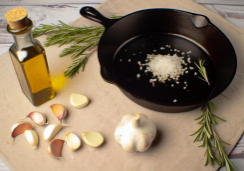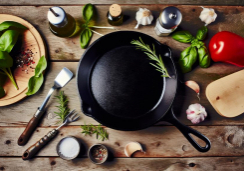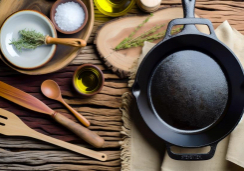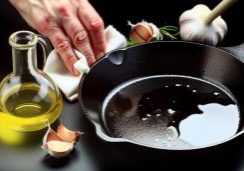How to Season a Cast Iron Skillet Perfectly
While you might've heard that seasoning your cast iron skillet is a tedious task, rest assured that with the right technique, it can be quite straightforward.
First, you need to understand that seasoning is simply the process of baking oil onto the iron to create a natural, non-stick coating.
You'll start by cleaning your skillet thoroughly, but the real secret to a perfect seasoning lies in the type of oil you use and how you apply it.
As you coat the skillet evenly and heat it properly, you're setting the stage for a durable, slick surface that can handle almost any culinary challenge.
In the following steps, you'll discover how to build this seasoning layer upon layer, ensuring your skillet not only performs well but also lasts for generations.
Stick around to uncover the nuances that make all the difference in achieving that perfect, glossy patina that cast iron enthusiasts rave about.
Clean Your Skillet Thoroughly
To ensure your cast iron skillet remains in top condition, always clean it thoroughly with hot water and a stiff brush after each use, avoiding soap to protect its valuable seasoning. The use of soapy water can remove a bit of seasoning you've worked hard to build up. Instead, focus on hot water and a sturdy brush to dislodge any stuck-on morsels.
If you're faced with stubborn residues, skip the scouring pads that could scratch and damage the surface. Opt for a mix of coarse salt and oil, which acts as a natural abrasive to break down the grime. After you've scoured the pan, rinse it well to ensure the pan is clean and free from any salty residue.
Once clean, it's crucial to dry it thoroughly. Any lingering moisture can lead to rust, undermining your skillet's integrity. To finish, coat the skillet with a light layer of oil, rubbing it in to maintain the non-stick patina.
Apply Oil Evenly
After ensuring your cast iron skillet is clean and dry, the next step is to apply a thin layer of melted shortening or vegetable oil across the entire surface, including the bottom and sides, for an even seasoning.
Now, you're at a pivotal moment in the seasoning process. Gently pour your chosen cooking oil with a high smoke point—vegetable oil works wonders—into the skillet.
Using a paper towel, rub the oil all over, ensuring you apply oil evenly. Work the thin layer across every inch, creating a uniform layer of oil that will be the foundation of your skillet's non-stick patina. It's crucial to cover the entire skillet to prevent rust and create a smooth cooking surface.
Take care to remove any excess oil with the paper towel—pools of oil can lead to a sticky, uneven finish. The goal here is a slick, appetizing sheen, not a greasy coating.
As you carefully distribute the oil, imagine the sumptuous meals you'll craft on this well-seasoned canvas. Once the skillet is evenly coated, you're ready to heat it and begin the transformation into a culinary heirloom.
Bake the Skillet
Now that you've coated your cast iron skillet with an even layer of oil, it's time to bake it in the oven at a temperature between 250-350°F (121-178°C) for one hour to set the seasoning. This crucial step in the seasoning process involves polymerization, a transformation where the oil bonds to the skillet, creating a protective layer that's both non-stick and rust-resistant.
Place your skillet upside down on the top rack of the oven to ensure even heating, and slide a baking sheet on the rack below to catch any drips. The oil will bake into the skillet, undergoing a chemical reaction that results in a layer of carbonized oil—a durable surface that makes your cast iron skillet a culinary treasure.
For a robust seasoning, it's best to repeat this baking process two or three times. Allow the cast iron skillet to cool completely in the oven after each session. This builds up a resilient coating that can withstand high heat and heavy use.
Cool and Repeat Process
Once your cast iron skillet has cooled completely in the oven, you're ready to start the seasoning cycle again to build a stronger non-stick surface. This process is essential to achieving a durable, oil-baked protective coating that makes your skillet a joy to cook with. By repeating the seasoning, you're layering on more polymerization, which is the key to a slick, rust-resistant finish.
Before you repeat, ensure the skillet is cool to the touch. Wipe off any excess oil gently—this prevents the seasoning from turning sticky or rancid. Now, apply a thin, even layer of oil once more, and heat your skillet as you did before. This repetition deepens the seasoning, enhancing your skillet's performance each time.
Avoid cooking acidic foods like tomatoes during the first few uses, as they can disrupt the seasoning process. Instead, cook foods that encourage the polymerization, like frying or sautéing vegetables. Remember, regular use of your cast iron will continue to improve the seasoning.
What are the benefits of seasoning a cast iron skillet perfectly?
Seasoning a cast iron skillet stepbystep is crucial for maintaining its non-stick surface and preventing rust. Proper seasoning creates a natural, easy-release finish that only gets better with use. It also adds flavor to your dishes and helps in evenly cooking food.
Maintain Regular Care
To ensure your cast iron skillet remains in top condition, regularly cook with oil and avoid abrasive utensils that can strip the seasoning. Each time you cook, you're not just whipping up delicious meals, you're also fortifying the layers of seasoning that make your cast iron cookware a kitchen favorite. The best oil for maintaining this hard-earned patina is one with a high smoke point, ensuring it bonds well during cooking.
When you use your cast iron, remember that maintenance is key. After cooking, you'll need to clean the skillet, but always steer clear of harsh soaps or scouring pads. Instead, rinse with warm water and use a brush or scraper to remove any stuck-on bits. Then, dry it thoroughly—water is the enemy of iron, after all.
Once dry, it's time for a touch-up. Warm the skillet slightly to open up its pores, then rub a light layer of oil onto the cooking surface. This simple act preserves the non-stick properties and keeps rust at bay.
Whether it's your daily go-to or an occasional cooking companion, treating your cast iron with care ensures a lifetime of impeccable performance.
Conclusion
You've mastered the art of seasoning your cast iron skillet! With each use, it'll perform better, making those home-cooked meals even more delicious. Just remember, a little care goes a long way. Keep it oiled, cook often, and your skillet's non-stick surface will thrive.
Embrace the joy of cooking with your perfectly seasoned cast iron, and watch as it becomes a cherished kitchen staple, imbuing every dish with that incomparable, well-earned flavor.
Happy cooking!










